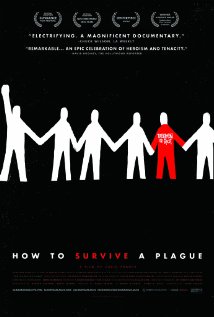 Last week, PBS' Independent Lens aired How to Survive a Plague, an Oscar-nominated documentary about the early years of AIDS activism and the work of ACT UP (AIDS Coalition to Unleash Power) to get the US government to respond effectively to the AIDS epidemic. Director David France was a journalist during that period, and by compiling material from over 700 hours of archived footage, he has created a moving and searing documentary about the failures and successes experienced by the LGBT community during this dark time.
Last week, PBS' Independent Lens aired How to Survive a Plague, an Oscar-nominated documentary about the early years of AIDS activism and the work of ACT UP (AIDS Coalition to Unleash Power) to get the US government to respond effectively to the AIDS epidemic. Director David France was a journalist during that period, and by compiling material from over 700 hours of archived footage, he has created a moving and searing documentary about the failures and successes experienced by the LGBT community during this dark time.
The documentary tells the story of ordinary people who came together to do truly extraordinary things. There were men like Larry Kramer, who could not idly stand by and helped found ACT UP to pursue political action in the midst of the AIDS crsis. There were women like Iris Long, an unassuming housewife with a science background, who decided that the members of ACT UP could have more of an impact on public policy if they received basic training in how grants were funded and drug research was conducted. These novices educated themselves, becoming experts who identified flaws in the ways that HIV drugs were being tested and proposed alternate streamlined processes that were ultimately adopted by the National Institutes of Health.
The buyers clubs are also featured, where drugs that weren't FDA-approved were smuggled into the country and sold to HIV-positive individuals who were taking all manner of drugs in the hopes of finding a miracle cure. The desperation of the time is starkly captured, with one of the buyers club members sarcastically commenting that he has every drug available, none of which will help fight AIDS. Even after AZT was approved as the first drug to target HIV, people couldn't afford its exorbitantly high cost, and members of ACT UP and its offshoot, TAG (Treatment Action Group), began to partner with pharmaceutical companies, in the hopes of developing affordable and less toxic treatments.
How to Survive a Plague chronicles the progress of AIDS activism year by year, grimly revealing the number of AIDS deaths as each year passed by without any effective therapy in sight. Many of the people featured in the documentary were HIV-positive individuals who died before more drugs and the power of combination therapy were discovered. Those who survived provide moving tributes to their fallen comrades, but they also suffer from significant survivor's guilt. However, many of them are still activists today, determined to keep up the fight and ensure that people stay educated and informed. The level of political engagement and influence they reached during those chaotic years is bewildering, and these everyday heroes literally helped to save millions of lives. They were articulate, passionate, and intelligent people and this documentary is a long overdue tribute to their tireless advocacy and refusal to accept the status quo.
No comments:
Post a Comment